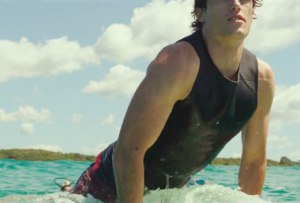Swimming is a great way to improve general fitness and burn calories, in addition to being enjoyable and refreshing. These five swimming exercises can help you reach your fitness objectives, whether your intent is to lose weight or simply maintain your current level of fitness. Take a look at these exercises to increase your level of fitness and burn the most calories.

1. HIIT, or high-intensity interval training
Tabata is a strenuous HIIT workout that will test your endurance and improve your anaerobic ability. Tabata workouts are renowned for their effectiveness in burning calories because they alternate between brief intervals of high activity and periods of rest.
Example Tabata Swim Workout, 30 minutes:
Warm-up: 600 meters of kick mixed with swimming.
Pre-Set: 8 x 25 meters with a selected drill and build swim alternately.
This workout will test your stamina and increase the number of calories you burn thereafter.
2. Strengthening Agent
Increasing swimming stamina and cardiovascular endurance is essential for enhancing general fitness. This exercise program is designed to increase your aerobic capacity by keeping a constant pace.
Sample Swim Workout for Endurance, 30 Minutes:
Warm-up: Five minutes of easy swimming.
Distância Freestyle: Maintain a reasonable pace while swimming nonstop for 20 minutes.
Swimming routines lasting five minutes include arm circles, underwater dolphin kicks, and sculling.
This exercise increases total endurance and builds a solid basis for longer swims.
3. Burning Fat Explosion
By combining different strokes, you may work out your entire body and engage more muscle groups, burning more calories overall.
An Example of a 30-Minute Swim Workout to Burn Fat:
5 minutes of easy swimming is the warm-up.
Main Set: For a total of twenty minutes, alternate between 100 meters of freestyle and 100 meters of backstroke.
This mixture helps burn fat efficiently while keeping your muscles guessing.
4. The Calorie Fire
Comparably to cycling or jogging, swimming can burn calories—especially when interval training is used. To optimize calorie expenditure, alternate between high-intensity and recuperation times.
Try interval swimming training; to burn more calories, alternate between intense swims and rest intervals.
This approach is a flexible way to burn calories because it can be modified according to your fitness level and objectives.
5. Playing Pool Parties
Mixing up your strokes and adding playful features will add enjoyment to your training. This exercise program still gives a great workout but with a humorous twist.
A thirty-minute Fun Swim Workout example
5 minutes of easy swimming is the warm-up.
Primary Set: Perform four repetitions of 25 meters each of the following swim strokes: freestyle, backstroke, breaststroke, and butterfly.
This exercise regimen keeps the workout interesting and varied in addition to burning calories.
Estimates of Calorie Burn for Various Swimming Styles
Swimming Lazily
For individuals who want to enjoy the water without doing a lot of work, swimming is a fantastic alternative because it burns calories moderately.
When swimming at a leisurely speed, one can burn between 430 and 575 calories per hour on average.
For example, a 150-pound (68 kg) person swimming backstroke recreationally can burn about 344 calories in an hour.

Swimming at a Moderate Intensity
Moderate swimming is the best for a balanced workout and increases calorie burn.
Approximately 223 calories can be burned in an hour at a moderate exertion.
About 3.5 METs (Metabolic Equivalent of Task) are associated with this.
Swimming with vigor
Intense swimming is the best option for people who want to burn as many calories as possible.
Swimming with vigor
able to burn 878 calories in an hour.
About 13.8 METs are equated to this level of effort.
These approximations are subject to change depending on certain conditions. One excellent option for effectively burning calories is swimming.
The Best Swimming Techniques to Burn Calories
Your choice of stroke has a big impact on how many calories you burn. Below is a summary of the most efficient strokes:
Butterfly Motion
Calorie Burn: The highest of all strokes, although it cannot be maintained for extended periods of time.
Benefit: Great for burning a lot of calories.
Method: Essential to effectiveness.
After the butterfly stroke, the breaststroke has the second-highest calorie burn.
Benefits: More long-lasting and engages many muscle areas.
Technique: Requires synchronized arm and leg movements
Crawl Forward (Freestyle)
Calorie Burn: For swimmers with training, effective and affordable.
Benefit: Adaptable and frequently utilized.
Technique: Put your attention on strong strokes and a streamlined posture.
Reverse stroke
Though less than other strokes, calorie burn is still rather potent.
Benefit: Excellent for strengthening back muscles and losing weight.
Technique: To ensure efficiency, the right technique must be used.
The secret to optimizing calorie burn during the stroke is proper execution.
Tips to Improve Your Butterfly Stroke
Swimming the butterfly is one of the hardest strokes to master. To help you get the hang of it, try these exercises and advice:
1. Use a Straight-Arm Recovery: To reduce excessive undulation and shoulder rotation, use a straight-arm recovery rather than a bent arm.
2. Swim with a Flatter Body Position: Try to keep your strokes from being too wide and strive for a “dry back.”
3.Lower Chin Lift When Breathing: To maintain a streamlined posture, keep your head down while breathing.
4. Breathe Late in the Stroke Cycle: As the arm pull comes to a conclusion, time your breath.
5.Kick Constantly: Throughout the stroke, keep your dolphin kick steady.
6. Use Shorter Distances for Training: Concentrate on technique over longer distances.
7.incorporate Drills: Try body position kicking, the 3-3-3 drill, and one-arm butterfly exercises.
8. Develop Core Strength: To increase stability and power, strengthen your core.
Common Butterfly Stroke Mistakes to Avoid
1. Lifting Your Head Too High: When inhaling, keep your chin at the water’s surface.
2. Sweeping Out After Hand Entry: Keep your hand entry just a little bit wider than your shoulder breadth.
3.Bent Elbow Recovery: Throughout the healing stage, keep your arms straight.
4, Excessive Knee Bending During a Dolphin Kick: The hips, not the knees, provide the force.
5.Inconsistent Breathing Pattern: Make sure your breathing has a regular pattern.
Effective Warm-Up Routine for Swimming
A planned warm-up sequence primes your body for maximum efficiency. This is a reference:
1. Cardiovascular Warm-Up: To increase heart rate, begin with mild aerobic workouts.
2. Dynamic Stretching: To increase flexibility, do dynamic stretches.
3. Mobility Exercises: Concentrate on joint mobility for motions unique to swimming.
4.Technique Drills: Include drills tailored to individual strokes.
5. Race-Pace Intervals: If you’re getting ready for a race, add quick bursts of race-pace swimming.
6. Mental Preparation: To center your thoughts, practice breathing exercises.
You Can Use Our Products with swimming
Cool-Down Routine After Swimming
A proper cool-down facilitates recuperation and helps avoid pain in the muscles:
1. Easy Swim: Move slowly and complete a few laps.
2. Static Stretches: Take deep stretches that target large muscle groups, holding each one for 20–30 seconds.
3.Deep Breathing: To help your body relax, take calm, deep breaths.
4. Hydrate: Drink water or a sports drink to rehydrate.
Preventing Shoulder Strain While Swimming
For swimmers, shoulder discomfort is a typical worry. The following are methods to avoid it:
1. Appropriate Technique: Pay attention to fluid, deliberate arm motions.
2. Gradual Training Load: Gradually extend your training range.
3.Rotator Cuff Strengthening: Build up the muscles in your rotator cuff.
4.Scapular Stability: Perform scapular push-ups to improve shoulder function.
5. Pay Attention to Your Body: If you experience pain, lower your workout intensity.
Improving Your Swimming Technique
You can improve your swimming technique over time, which will greatly improve your performance. The following are important pointers:
1. Body Position: To prevent drag, keep your body parallel to the waterline.
2. Breathing: Do not raise your head; instead, exhale underwater.
3. Arms: To enhance propulsion and minimize water contact while moving forward.
4. Drills & Practice: Include drills designed especially for freestyle maneuvers.
To make improvements, consistency and attention to detail are crucial. Have fun swimming!
In summary
Depending on your goals and degree of fitness, modify the length and intensity of these exercises. These swimming exercises can help you burn calories quickly and efficiently, regardless of whether your goal is a high-intensity workout or a fun, varied session. Go for fitness and have fun while doing it—happy swimming!



